ZTE Blade II User Manual
BLADE II
WCDMA/GSM Mobile Phone
User Manual
LEGAL INFORMATION
Copyright © 2011 ZTE CORPORATION.
All rights reserved.
No part of this publication may be quoted, reproduced, translated or used in any form or by any means, electronic or mechanical, including photocopying and microfilm, without the prior written permission of ZTE Corporation.
The manual is published by ZTE Corporation. We reserve the right to make modifications on print errors or update specifications without prior notice. Every effort has been made in the preparation of this manual to ensure accuracy of the contents, but all statements, information, and recommendations in this manual do not constitute a warranty of any kind, expressed or implied.
The Bluetooth® trademark and logos are owned by the Bluetooth SIG, Inc. and any use of such trademarks by ZTE Corporation is under license. Other trademarks and trade names are the property of their respective owners.
Version No.: R1.0
Edition Time : 20120301
This equipment may be operated in the following countries:
AT |
DE |
MT |
GB |
BE |
GR |
NL |
IS |
CY |
HU |
PL |
LI |
CZ |
IE |
PT |
NO |
DK |
IT |
SK |
CH |
EE |
LV |
SI |
BG |
FI |
LT |
ES |
RO |
FR |
LU |
SE |
TR |
Contents |
|
For Your Safety ...................................................... |
11 |
General Safety ............................................................ |
11 |
Radio Frequency (RF) Exposure ................................. |
12 |
General Statement on RF Energy .......................... |
12 |
Specific Absorption Rate (SAR).............................. |
12 |
Body Worn Operation............................................. |
13 |
Limiting Exposure to Radio Frequency (RF) Fields. 13 |
|
Regulatory Information ........................................... |
14 |
National Restrictions on Wi-Fi Usage........................... |
14 |
Distraction ................................................................... |
15 |
Driving.................................................................... |
15 |
Operating Machinery .............................................. |
16 |
Product Handling ......................................................... |
16 |
General Statement on Handling and Use ............... |
16 |
Small Children........................................................ |
17 |
Demagnetization .................................................... |
17 |
Electrostatic Discharge (ESD) ................................ |
17 |
Antenna ................................................................. |
18 |
Normal Use Position .............................................. |
18 |
Air Bags ................................................................. |
19 |
Seizures/ Blackouts................................................ |
19 |
Repetitive Motion Injuries ....................................... |
19 |
Emergency Calls .................................................... |
20 |
Loud Noise............................................................. |
20 |
Phone Heating ....................................................... |
20 |
4
Electrical Safety ........................................................... |
20 |
Accessories ............................................................ |
20 |
Connection to a Car................................................ |
21 |
Faulty and Damaged Products................................ |
21 |
Interference.................................................................. |
21 |
General Statement on Interference ......................... |
21 |
Pacemakers ........................................................... |
21 |
Hearing Aids ........................................................... |
22 |
Medical Devices ..................................................... |
22 |
Hospitals................................................................. |
22 |
Aircraft.................................................................... |
22 |
Interference in Cars ................................................ |
23 |
Explosive Environments ............................................... |
23 |
Petrol Stations and Explosive Atmospheres............ |
23 |
Blasting Caps and Areas ........................................ |
23 |
Getting Started....................................................... |
24 |
Overview...................................................................... |
24 |
Keys Explained ............................................................ |
25 |
Starting up ................................................................... |
26 |
Installing the SIM/microSD Card and Battery .......... |
26 |
Removing the Battery and SIM/microSD Card ........ |
28 |
Charging the Battery............................................... |
28 |
Switching Your Phone On/Off....................................... |
29 |
Setting Up Your Phone for the First Time................ |
29 |
Switching to Sleep Mode ........................................ |
30 |
Waking up Your Phone ........................................... |
30 |
5 |
|
Getting Around ............................................................ |
31 |
Touch Control ........................................................ |
31 |
Home Screen ......................................................... |
31 |
Status and Notification Icons .................................. |
34 |
Using the Notification Panel ................................... |
36 |
Re-open Recently-used Applications...................... |
36 |
Phone Calls ............................................................ |
38 |
How to Make Calls....................................................... |
38 |
Calling from the Dialer............................................ |
38 |
Calling from Your Contacts..................................... |
38 |
Calling from Your Call History ................................ |
39 |
Calling from a Text Message.................................. |
39 |
Using Speed Dial ................................................... |
39 |
How to Receive Calls .................................................. |
40 |
Answering a Call .................................................... |
40 |
Rejecting a Call...................................................... |
40 |
Muting a Call .......................................................... |
40 |
Putting a Call on Hold............................................. |
41 |
Turning the Speakerphone On/Off.......................... |
41 |
Ending a Call.......................................................... |
41 |
Adjusting Your Call Settings ........................................ |
41 |
Contacts ................................................................. |
43 |
Importing and Exporting Contacts................................ |
43 |
Import/Export Contacts from/to the SIM Card ......... |
43 |
Import/Export Contacts from/to the microSD Card.. |
44 |
Creating a Contact....................................................... |
44 |
6 |
|
Adding a Contact to Favorites ...................................... |
44 |
Searching for a Contact................................................ |
45 |
Creating a New Group ................................................. |
45 |
Entering Text.......................................................... |
46 |
Android Keyboard ........................................................ |
46 |
Swype Text Input ......................................................... |
47 |
Selecting Touch Input Settings..................................... |
50 |
Messaging .............................................................. |
51 |
The Message Box ........................................................ |
51 |
Sending a Message ..................................................... |
51 |
Changing Message Settings ........................................ |
52 |
Email ....................................................................... |
55 |
Creating an Email Account........................................... |
55 |
Receiving Emails ......................................................... |
56 |
Composing and sending an Email ................................ |
56 |
Replying to or Forwarding an Email.............................. |
57 |
Deleting an Account ..................................................... |
57 |
Email Settings .............................................................. |
57 |
Getting Connected to the Internet........................ |
58 |
Adding a New GPRS/EDGE/3G Connection ................ |
58 |
Turning on Wi-Fi .......................................................... |
59 |
Connecting to a Wi-Fi Network..................................... |
59 |
Checking the Wi-Fi Network Status .............................. |
59 |
Using the Phone as a Modem ...................................... |
60 |
Enabling the Phone as a Modem ............................ |
60 |
7 |
|
Disabling the Modem Function ............................... |
61 |
Using the Phone as a Wi-Fi Hotspot ............................ |
61 |
Enabling the Wi-Fi Hotspot..................................... |
62 |
Disabling the Wi-Fi Hotspot .................................... |
62 |
Browsing the Internet ............................................ |
63 |
Browsing Options ........................................................ |
63 |
Using Bookmarks ........................................................ |
64 |
Editing a Bookmark ................................................ |
64 |
Deleting a Bookmark.............................................. |
64 |
Changing Browser Settings ......................................... |
65 |
Bluetooth® .............................................................. |
66 |
Making the Most of Multimedia............................. |
67 |
Taking Pictures with Your Camera............................... |
67 |
Adjusting Camera Settings ..................................... |
67 |
Shooting Video with Your Camcorder .......................... |
68 |
Adjusting Your Video Settings ................................ |
68 |
Listening to Your FM Radio ......................................... |
68 |
Playing Your Music...................................................... |
69 |
Creating Playlists ................................................... |
70 |
Managing Playlists ................................................. |
70 |
Setting a Song as Ringtone.................................... |
71 |
Playing Your Videos .................................................... |
71 |
Opening Your Gallery .................................................. |
72 |
Making Memorable Memos.......................................... |
72 |
8 |
|
Using Your Google™ Applications ...................... |
74 |
Gmail ........................................................................... |
74 |
Using Google Calendar ................................................ |
75 |
Using Google Talk........................................................ |
75 |
Opening Google Talk.............................................. |
75 |
Adding a New Friend .............................................. |
75 |
Changing Your Online Status.................................. |
76 |
Starting a Chat........................................................ |
76 |
Places.......................................................................... |
76 |
Latitude........................................................................ |
77 |
Sorting out Your Phone Settings ......................... |
78 |
Setting Time and Date ................................................. |
78 |
Changing Display Settings ........................................... |
78 |
Sound Settings............................................................. |
78 |
Language Settings ....................................................... |
79 |
Mobile Network Services.............................................. |
80 |
Getting Data Services while Abroad........................ |
80 |
Disabling Data Services.......................................... |
80 |
Enabling Always-on Data Services ......................... |
80 |
Switching Network Modes....................................... |
81 |
Switching Networks ................................................ |
81 |
Setting Access Point Names................................... |
81 |
Security Settings .......................................................... |
82 |
Protecting Your Phone with a Screen Unlock Pattern |
|
............................................................................... |
82 |
Protecting Your Phone with a PIN or Password ...... |
83 |
9 |
|
Disabling Screen Unlock Security........................... |
84 |
Protecting Your SIM with a PIN .............................. |
84 |
Setting up Credential Storage ................................ |
85 |
Managing Your Device Memory................................... |
86 |
Privacy: Reset to Factory Settings ............................... |
86 |
Managing Applications................................................. |
87 |
Installing an Application ............................................... |
87 |
Managing Other Settings ............................................. |
88 |
Search Settings...................................................... |
88 |
Voice Interaction .................................................... |
88 |
Accessibility ........................................................... |
89 |
Other Applications................................................. |
90 |
Alarm........................................................................... |
90 |
Note Pad ..................................................................... |
90 |
Calculator .................................................................... |
90 |
SIM Toolkit .................................................................. |
91 |
Task Manager ............................................................. |
91 |
Stopwatch ................................................................... |
91 |
Software Update.......................................................... |
91 |
Specifications......................................................... |
92 |
Declaration of RoHS Compliance ......................... |
93 |
Disposal of Your Old Appliance ........................... |
94 |
EC DECLARATION OF CONFORMITY .................. |
95 |
10 |
|

For Your Safety
General Safety
|
Don’t make or receive |
|
|
|
handheld calls while |
|
Don’t use at petrol |
|
driving. And never text |
|
stations. |
|
while driving. |
|
|
|
|
|
|
|
Keep your phone at |
|
|
|
least 15mm away from |
|
Your phone may produce |
|
your ear or body while |
|
a bright or flashing light. |
|
making calls. |
|
|
|
|
|
|
|
Small parts may cause |
|
Don’t dispose of your |
|
a choking. |
|
phone in fire. |
|
|
|
|
|
Your phone can |
|
Avoid contact with |
|
produce a loud sound. |
|
anything magnetic. |
|
|
|
|
|
Keep away from |
|
|
|
pacemakers and other |
|
Avoid extreme |
|
electronic medical |
|
temperatures. |
|
devices. |
|
|
|
|
|
|
|
Switch off when asked |
|
Avoid contact with |
|
to in hospitals and |
|
liquids. Keep your phone |
|
medical facilities. |
|
dry. |
|
|
|
|
|
Switch off when told to |
|
Don’t take your phone |
|
in aircrafts and airports. |
|
apart. |
|
|
|
|
11

Switch off when near explosive materials or
Only use approved
liquids.
accessories.
Don’t rely on your phone for emergency communications.
Radio Frequency (RF) Exposure
General Statement on RF Energy
Your phone contains a transmitter and a receiver. When it is ON, it receives and transmits RF energy. When you communicate with your phone, the system handling your call controls the power level at which your phone transmits.
Specific Absorption Rate (SAR)
Your mobile device is a radio transmitter and receiver. It is designed not to exceed the limits for exposure to radio waves recommended by international guidelines. These guidelines were developed by the independent scientific organization ICNIRP and include safety margins designed to assure the protection of all persons, regardless of age and health.
The guidelines use a unit of measurement known as Specific Absorption Rate, or SAR. The SAR limit for mobile devices is 2 W/kg and the highest SAR value for this device when tested at the ear was 1.54 W/kg*. As mobile devices offer a range of functions, they can be used in other positions, such as on
12
the body as described in this user guide**.
As SAR is measured utilizing the device’s highest transmitting power, the actual SAR of this device while operating is typically below that indicated above. This is due to automatic changes to the power level of the device to ensure it only uses the minimum power required to communicate with the network.
*The tests are carried out in accordance with EN 50360, EN 62311, EN 62209-1, EN 62209-2.
**Please see body worn operation.
Body Worn Operation
Important safety information regarding radio frequency radiation (RF) exposure:
To ensure compliance with RF exposure guidelines the phone must be used with a minimum of 15 mm separation from the body.
Failure to observe these instructions could result in your RF exposure exceeding the relevant guideline limits.
Limiting Exposure to Radio Frequency (RF) Fields
For individuals concerned about limiting their exposure to RF fields, the World Health Organization (WHO) provides the following advice:
Precautionary measures: Present scientific information
13
does not indicate the need for any special precautions for the use of mobile phones. If individuals are concerned, they might choose to limit their own or their children’s RF exposure by limiting the length of calls, or using ‘hands-free’ devices to keep mobile phones away from the head and body.
Further information on this subject can be obtained from the WHO home page http://www.who.int/peh-emf (WHO Fact sheet 193: June 2000).
Regulatory Information
The following approvals and notices apply in specific regions as noted.
Please find the section Declaration of RoHS Compliance and CE DOC in the end of this manual.
National Restrictions on Wi-Fi Usage
2400.0-2483.5 MHz
Country |
Restrictions |
Reason/remark |
Bulgaria |
|
General authorization |
|
|
required for outdoor use |
|
|
and public service |
France |
Please don't |
Military Radiolocation use. |
|
use WIFI |
Refarming of the 2.4 GHz |
|
function |
band has been ongoing in |
|
outdoors |
recent years to allow |
14
|
|
current relaxed regulation. |
|
|
Full implementation |
|
|
planned 2012. |
Italy |
|
If used outside of own |
|
|
premises, general |
|
|
authorization is required. |
Luxembourg |
None |
General authorization |
|
|
required for network and |
|
|
service supply (not for |
|
|
spectrum). |
Norway |
Implemented |
This subsection does not |
|
|
apply for the geographical |
|
|
area within a radius of 20 |
|
|
km from the centre of |
|
|
Ny-Ålesund. |
Russian |
|
Only for indoor |
Federation |
|
applications. |
Distraction
Driving
Full attention must be given to driving at all times in order to reduce the risk of an accident. Using a phone while driving (even with a hands free kit) can cause distraction and lead to an accident. You must comply with local laws and regulations restricting the use of wireless devices while driving.
15
Operating Machinery
Full attention must be given to operating the machinery in order to reduce the risk of an accident.
Product Handling
General Statement on Handling and Use
You alone are responsible for how you use your phone and any consequences of its use.
You must always switch off your phone wherever the use of a phone is prohibited. Use of your phone is subject to safety measures designed to protect users and their environment.
Always treat your phone and its accessories with care and keep it in a clean and dust-free place.
Do not expose your phone or its accessories to open flames or lit tobacco products.
Do not expose your phone or its accessories to liquid, moisture or high humidity.
Do not drop, throw or try to bend your phone or its accessories.
Do not use harsh chemicals, cleaning solvents, or aerosols to clean the device or its accessories.
Do not paint your phone or its accessories.
16
Do not attempt to disassemble your phone or its accessories, only authorized personnel can do so.
Do not expose your phone or its accessories to extreme temperatures, minimum - [5] and maximum + [50] degrees Celsius.
Please check local regulations for disposal of electronic products.
Do not carry your phone in your back pocket as it could break when you sit down.
Small Children
Do not leave your phone and its accessories within the reach of small children or allow them to play with it.
They could hurt themselves or others, or could accidentally damage the phone.
Your phone contains small parts with sharp edges that may cause an injury or may become detached and create a choking hazard.
Demagnetization
To avoid the risk of demagnetization, do not allow electronic devices or magnetic media close to your phone for a long time.
Electrostatic Discharge (ESD)
Do not touch the SIM card’s metal connectors.
17
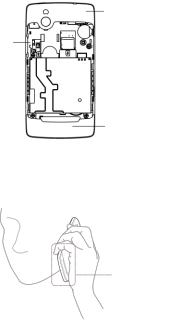
Antenna
GPS antenna
Bluetooth & Wi-Fi
antenna
Antenna
Do not touch the antenna unnecessarily.
Normal Use Position
When placing or receiving a phone call, hold your phone to your ear, with the bottom towards your mouth.
Antenna
18
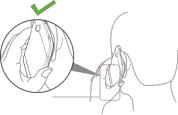
Air Bags
Do not place a phone in the area over an air bag or in the air bag deployment area.
Store the phone safely before driving your vehicle.
Seizures/ Blackouts
The phone can produce a bright or flashing light.
Repetitive Motion Injuries
To minimize the risk of RSI when texting or playing games with your phone:
Do not grip the phone too tightly.
Press the buttons lightly.
Use the special features which are designed to minimize the times of pressing buttons, such as Message Templates and Predictive Text.
19
Take lots of breaks to stretch and relax.
Emergency Calls
This phone, like any wireless phone, operates using radio signals, which cannot guarantee connection in all conditions. Therefore, you must never rely solely on any wireless phone for emergency communications.
Loud Noise
This phone is capable of producing loud noises, which may damage your hearing. Turn down the volume before using headphones, Bluetooth stereo headsets or other audio devices.
Phone Heating
Your phone may become warm during charging and during normal use.
Electrical Safety
Accessories
Use only approved accessories.
Do not connect with incompatible products or accessories.
Take care not to touch or allow metal objects, such as coins or key rings, to contact or short-circuit the battery terminals.
20
Connection to a Car
Seek professional advice when connecting a phone interface to the vehicle electrical system.
Faulty and Damaged Products
Do not attempt to disassemble the phone or its accessory.
Only qualified personnel can service or repair the phone or its accessory.
If your phone or its accessory has been submerged in water, punctured, or subjected to a severe fall, do not use it until you have taken it to be checked at an authorized service centre.
Interference
General Statement on Interference
Care must be taken when using the phone in close proximity to personal medical devices, such as pacemakers and hearing aids.
Pacemakers
Pacemaker manufacturers recommend that a minimum separation of 15 cm be maintained between a mobile phone and a pacemaker to avoid potential interference with the pacemaker. To achieve this, use the phone on the opposite ear to your pacemaker and do not carry it in a breast pocket.
21
Hearing Aids
People with hearing aids or other cochlear implants may experience interfering noises when using wireless devices or when one is nearby.
The level of interference will depend on the type of hearing device and the distance from the interference source, increasing the separation between them may reduce the interference. You may also consult your hearing aid manufacturer to discuss alternatives.
Medical Devices
Please consult your doctor and the device manufacturer to determine if operation of your phone may interfere with the operation of your medical device.
Hospitals
Switch off your wireless device when requested to do so in hospitals, clinics or health care facilities. These requests are designed to prevent possible interference with sensitive medical equipment.
Aircraft
Switch off your wireless device whenever you are instructed to do so by airport or airline staff.
Consult the airline staff about the use of wireless devices on board the aircraft. If your device offers a ‘flight mode’, this
22
must be enabled prior to boarding an aircraft.
Interference in Cars
Please note that because of possible interference to electronic equipment, some vehicle manufacturers forbid the use of mobile phones in their vehicles unless a hands-free kit with an external antenna is included in the installation.
Explosive Environments
Petrol Stations and Explosive Atmospheres
In locations with potentially explosive atmospheres, obey all posted signs to turn off wireless devices such as your phone or other radio equipment.
Areas with potentially explosive atmospheres include fuelling areas, below decks on boats, fuel or chemical transfer or storage facilities, areas where the air contains chemicals or particles, such as grain, dust, or metal powders.
Blasting Caps and Areas
Power off your mobile phone or wireless device when in a blasting area or in areas posted power off “two-way radios” or “electronic devices” to avoid interfering with blasting operations.
23
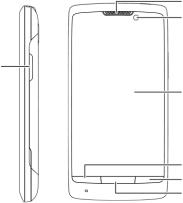
Getting Started
Overview
Earpiece
Front
Camera
Volume
Key
Touch
Screen
Menu Key
Back Key
Home Key
24
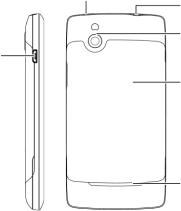
Power Key
Headset
Jack
Camera with LED
Charger/ flash USB Jack
Battery
Cover
|
Loud- |
|
speaker |
Keys Explained |
|
Key |
Function |
|
|
Power Key |
Hold to turn on or off Silent or Airplane |
|
mode, or to power off. |
|
Hold to turn on the phone. |
|
Press to switch your phone to Sleep mode. |
|
Press to wake up your phone. |
|
|
|
25 |

Key |
Function |
|
|
Home Key |
Press to return to the Home Screen from |
|
any application or screen. |
|
Hold to see recently used applications or |
|
open Task Manager. |
|
|
Menu Key |
Press to get the options for the current screen. |
|
|
Back Key |
Press to go to the previous screen. |
|
|
Volume Key |
Press or hold either end of the key to turn the |
|
volume up or down. |
|
|
Starting up
Installing the SIM/microSD Card and Battery
Switch off your phone before installing or replacing the battery, SIM, or memory card.
1.Open the back cover from the same end at either side and remove it.
26

2.Hold the SIM with the cut corner oriented as shown and slip it into the card holder.
3. Hold your microSD card and slide it in.
microSD logo  is a trade mark of the SD Card 27
is a trade mark of the SD Card 27
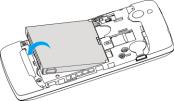
Association.
4.Insert the battery by aligning the gold contacts on the battery with the gold contacts in the battery compartment. Gently push down on the battery until it clicks into place.
5.Press the cover gently back into place until you hear a click.
Removing the Battery and SIM/microSD Card
1.Make sure that your mobile phone is off.
2.Remove the back cover.
3.Lift the battery up and out.
4.Slide the SIM out.
5.Slide the microSD card out.
Charging the Battery
When you first get your new phone you’ll need to charge the battery.
28
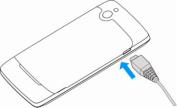
1.Connect the adapter to the charger jack. Ensure that the adapter is inserted with the correct orientation. Do not force the connector into the charger jack.
2.Connect the charger to a standard AC wall outlet.
3.Disconnect the charger when the battery is fully charged.
Switching Your Phone On/Off
Make sure the SIM is in your device and the battery is charged.
Hold Power Key to switch on your phone.
To switch it off, hold Power Key to get the phone options. Select Power off, and then tap OK.
Setting Up Your Phone for the First Time
When you first power on your phone after you purchase it or reset it to factory settings (see Sorting out Your Phone Settings – Privacy: Reset to Factory Settings), you need to
29
